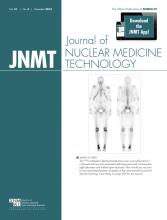
Scott Holbrook, BS, CNMT, FSNMMI-TS
There has been tremendous excitement regarding biomarkers that provide in vivo information on neurodegenerative diseases. Until now, diagnosis has been through clinical evaluation, which often leads to inconclusive findings or misdiagnosis. With new tools available for characterization of neurodegenerative disease, for the first time clinicians are able to obtain objective information that could lead to a definitive diagnosis and more appropriate therapy. With disease-modifying treatments on the horizon, the role of PET and molecular imaging in providing differential diagnosis and in directing and monitoring treatment should be of ever-increasing importance.
In January 2011, the U.S. Food and Drug Administration (FDA) approved 123I-ioflupane injection (DaTscan; GE Healthcare) for visualization of dopamine transporters to aid in characterization of essential tremor and parkinsonian syndromes such as Parkinson disease and supranuclear palsy. A positive 123I-ioflupane study is indicative of idiopathic Parkinson disease, multiple-system atrophy, or progressive supranuclear palsy. Additionally, 123I-ioflupane may prove useful in detection of Lewy body dementias. However, because the test cannot differentiate between these indications, it is considered an adjunct to other diagnostic tests.
The FDA continued to recognize the importance of radiopharmaceuticals in neurodegenerative imaging in April 2012, when it approved the first proprietary PET imaging agent, florbetapir (Amyvid; Eli Lilly and Co.), for use in quantifying β-amyloid protein accumulation in the brain of patients who may be at risk for Alzheimer disease. In January 2013, the SNMMI and the Alzheimer’s Association jointly published the first criteria for the appropriate use of this imaging technology to aid in the diagnosis of people with suspected Alzheimer disease. The aim of these appropriate-use criteria is to provide guidance for physicians, individuals, and families affected by Alzheimer disease, as well as the public.
Most recently, the FDA approved a second imaging agent for brain β-amyloid imaging—18F-flumetamol injection (Vizamyl; GE Healthcare)—in October 2013. This radiopharmaceutical is indicated for PET imaging of the brain to estimate β-amyloid neuritic plaque density in adult patients with cognitive impairment who are being evaluated for Alzheimer disease or other causes of cognitive decline.
Furthermore, there are additional radiopharmaceuticals in various stages of approval or clinical trials for quantification of β-amyloid burden, such as florbetaben and NAV 4694. The potential for this area of molecular imaging is high, and with continued development we will be able to substantially improve the care we provide to patients and the support we can offer to caregivers.
Currently, definitive diagnosis of Alzheimer disease consists of postmortem autopsy confirmation of β-amyloid plaques and neurofibrillary tangles composed of τ protein. Looking beyond just β-amyloid burden, there are currently clinical trials of a few compounds that target τ protein. Characterization of β-amyloid plaques and τ tangles with PET imaging could allow, for the first time, diagnosis of Alzheimer disease with a high degree of confidence in the living patient.
Although the advances in technology allow us to offer valuable diagnostic tests for those with dementia, there are limitations that go along with these newly approved radiopharmaceuticals—particularly those for β-amyloid PET imaging. The Centers for Medicare and Medicaid Services this fall announced it would cover a single PET scan for evaluation of β-amyloid burden, but only for patients participating in specific clinical studies under a coverage-with-evidence-development (CED) program, which grants conditional reimbursement upon collection of specific data. The appropriate-use criteria jointly developed by the Alzheimer’s Association and SNMMI demonstrated that more than adequate evidence exists for Medicare to cover β-amyloid PET. SNMMI looks forward to working with all stakeholders to establish an appropriate method to meet the required CED process so that this valuable test can be offered to patients.
There are numerous therapies in late-stage clinical trials designed to remove excess β-amyloid protein from the brain of patients with suspected Alzheimer disease. In the future, through proper patient selection, biomarker imaging confirmation, and plaque burden assessment, patients at risk will be given a disease-modifying therapy that will either significantly delay the onset or prevent the development of Alzheimer disease.







